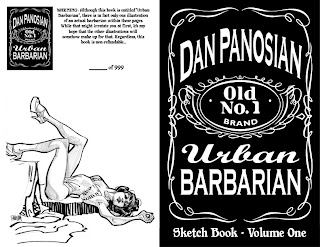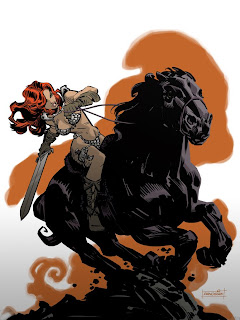DAN PANOSIAN INTERVIEW
Comic Book Artist, Illustrator, And Concept Artist.
Tuesday, February 17, 2009
BROUGHT TO YOU BY THE CHARACTER DESIGN BLOGSPOT
IF YOU WOULD LIKE TO SEE MORE INTERVIEWS GO TO THE HOME PAGE BY CLICKING HERE
The Interview

Tell me a little bit about yourself, about your life? What helped prepare you to become the artist that you are today?
That's a very broad question. My life is pretty hectic. I'm lucky that I'm as busy as I am. I've had times in my career where things have been slow and it's those times that you think you'll work on your personal projects. For me that's never the case. I get lazy. So a busy schedule keeps me on track. Dave Johnson, Jeff Johnson and I started a club called Drink and Draw a few years ago and it's quite a bit of fun. So when I'm not working, I'm, um, drawing. Hey, no one picks this career because they "had to". You do it because you love it. If you don't, seriously - find another line of work because it's tough!
My father was an artist so I guess I had a bit of an advantage. Granted, he didn't want me to pursue art as a career. So he gave me one art lesson when I was about six years old. Through my formative years he would critique me but that was it as far as lessons went. I never went to art school and that's something I wish wasn't the case. A good art school can make a huge difference. Luckily, when I moved to NYC I met a lot of very talented artists that pushed me in the right directions. By surrounding myself with talent I was forced to improve or fade away. I'm still learning all the time. I have so much to learn it's almost numbing!
How do you go about drawing, and what goes through your mind, from start to end?
Like most artists, I start with very rough/vague scribbles. In some cases, thumbnails. I try to keep things loose so that if the drawing doesn't work out I haven't invested a lot of time noodling it to death. I try not to press the pencil too hard so that every line is just like a brush line. My round file is always pretty full.
Once I stumble on something I like, I tighten it up by scanning it on the computer. I have a Wacom Cintiq and I use Photo Shop too to add details. If it's a comic book page, I'll print out a full size version and lightbox it for inking [then it's scanned back in and cleaned up in PS]. Otherwise, I'll create a new layer and digitally ink a character or turn.
What goes through my mind? Honestly, a whole lot of editing. Ideally I'm thinking about pairing down the design at all times. I'm asking myself what is most essential. How can I lead the eye? Where is my focus? What is my design objective? How can I frame within a framing device? Have I created any tangents?
What is a typical day for you, and who are the people you work with?
A typical day is half drawing and half interfacing with clients. Generally I'm juggling two or three jobs at once. It's something you have to do when you're freelance. If the work flow gets too intense I outsource. I'd prefer not to but I have a great network of talented artists I call on occasionally.
What are some of the things that you have worked on?
Nearly every title for Marvel and DC Comics and a lot of Image Comics. Most notably, X-Men books. I've done a handful of DVD covers, Video Game covers and book covers. There's been a lot of video game design too.
What are you working on now? (if you can tell us)
I just finished X-Men Origins:Sabretooth for Marvel Comics and now I'm doing a series of covers for Mark Waid's new comic book Irredeemable. I'm not sure what's after that. Generally, I have a lot of toy design work to do and the occasional Children's Book. But I would like to narrow my focus back to the comic book field.
Who do you think are some of the top artists out there?
Design wise? There are almost too many to count. When it comes to animation, I would say Sean Galloway is exceptionally appealing. So is Dave Johnson. As artists, I look at Eric Canete, Sean Gordon Murphy, Adam Hughes, Andrew Robinson and Dave Johnson. But truthfully, I look at tons of artists. There really are too many to name.
Could you talk about your process in coloring your art, as well as the types of tools or media that you use?
I use Photoshop and on rare occasions I'll use colored pencils and Copic Markers. PS is a very easy process for coloring. You can go easy or you can put all your time into it. It's up to you. With design, I'll generally put just enough in to establish mood and suggest a harmonious palette.
What part of designing is most fun and easy, and what is most hard?
The most difficult thing is staying fresh. It's easy to stick to what's worked before. But that philosophy can keep you in a rut and you land up repeating yourself. The easiest part, for me is the "finish". By then, all the hard work is done. When you've decided upon a proper design it's time to put the icing on the cake. That's the polish. That's the sparkle. Exciting things can happen from there and for me; it's always the most fun.
What are some of the things that you do to keep yourself creative?
I look at Deviant Art. I attend as many Life Drawing studies as I can. Here in Los Angeles you can almost find a life drawing studio any day of the week. Generally you donate $10 or $15 for a few hours. Its money well spent.
The trick is drawing outside your comfort level. Meaning, ideally you should approach the sessions differently than you would if you're working. If you sketch with a marker on the job - grab a charcoal pencil and try going strictly tonal. It's the only way to insure you'll make impressive leaps in skill. If you stick to what you know, then you're only going to marginally improve by doing the same thing again and again. You have to cross train.
You can bring that tonal work into your pen work. If you draw only in black and white, it's time you experimented with color. You'll be amazed at how much better your pen and ink will be. You're understanding of form changes/improves. The way you look at shapes and forms changes. You see things in a brand new manner. All of sudden, drawing is new again. Challenging. Rising to the challenge is what breeds change and improvement. I'm constantly surprised by artists that resist this opportunity. Like most things in life, we prefer sticking to what we know. Change scares us. But change is good. Change provides grow.
What are some of your favorite pieces of art work that you have seen?
Work I've seen? My favorite work is probably by Frank Frazetta. There's no one else quite like him. He's a hard one to beat.
What is your most favorite subject to draw? And why?
I love anything Robert E. Howard. Or, you could say, anything Frank Frazetta. The two share very similar predilections.
What inspired you to become an Artist?
My father. He was quite an artist and a premier designer. He always really enjoyed the comic book medium. He bought me my first Batman comic book and took me to see Conan. That was pretty much it. I was hooked. Sadly, I think he would of wished I would of become a doctor.
What are some of the neat things you have learned from other artists that you have worked with or seen?
In general, artists are pretty stingy about sharing techniques. Neal Adams showed me quite a bit for the brief time I worked with him. Back in the Nineties Mark Pacella showed me a lot of turn of the century illustrators and really opened my eyes to a world outside of comic books. Dave Johnson is pretty liberal with critiques which is always very helpful. If I draw a sword he'll say, "draw it bigger. Make it mean something. Give it impact." Dave is excellent at making everything count. He doesn't spare any design aspect. If you put it in the drawing, use it. Otherwise, less is more.
What are some of your favorite websites that you go to?
I'm on Deviant Art all the time. Sometimes I hit the blogosphere to get that incentive. There are so many creative talents out there it's hard not to be inspired. I'm literally looking at everyone and checking out what's new. There's so many approaches to good design.
What wisdom could you give us, about being an Artist? Do you have any tips you could give?
Always compare your work to the very best. That's the barometer. Ask yourself what he/she is doing better/differently, etc. Analyze and note the differences. Don't settle for "it's good enough". Comparing yourself to the best talent out there shouldn't stop you from delivering though. But it should help you to up your game and be as competitive as you're able. The moment you stop learning is the moment your work is going to become stale. When your work becomes stale - watch out! That means you better think about retirement because the art world changes very quickly. Keep up to stay up.
If people would like to contact you, how would you like to be contacted?
I prefer email. Info@danpannosian.com
Finally, do you have any of your art work for sale (sketchbooks, prints, or anything) for people that like your work can know where and when to buy it?
I have a sketchbook and a print available at my website, www.urbanbarbarian.com

Subscribe to:
Comments (Atom)



























